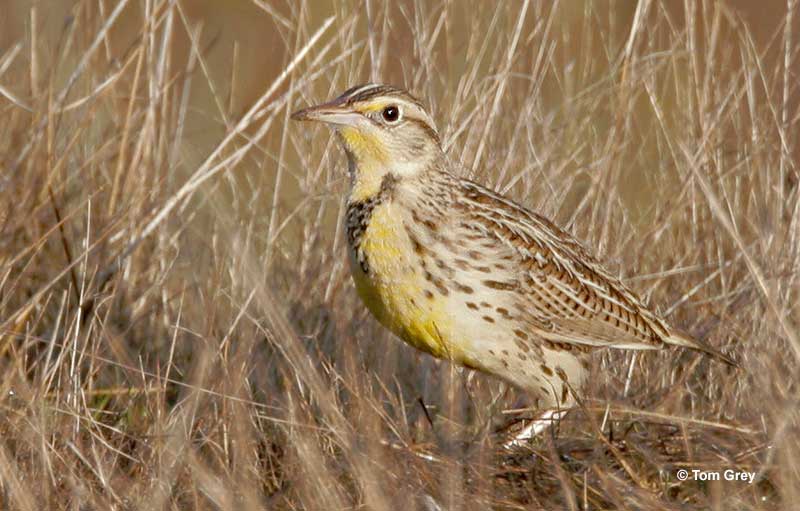
North Dakota is a northern state with 70,705 square miles of bird-filled marshes, grasslands, and farms. The Peace Garden State is also home to nearly 800,000 people and more than 400 bird species!
The North Dakota state bird title belongs to the Western Meadowlark. Its pleasant song and bright yellow colors highlight North Dakota’s dramatic open spaces throughout the state.
On this page
The Official State Bird of North Dakota
The Western Meadowlark (Scientific name: Sturnella neglecta) became the state bird of North Dakota in 1947. During that year, the state legislature legally declared this species to be an official symbol of North Dakota.
As with other states during the 1930s and 1940s, Federated Women’s Clubs were campaigning and lobbying state officials to choose a bird to represent the state. They often had support from local birding clubs, especially Audubon Society chapters.
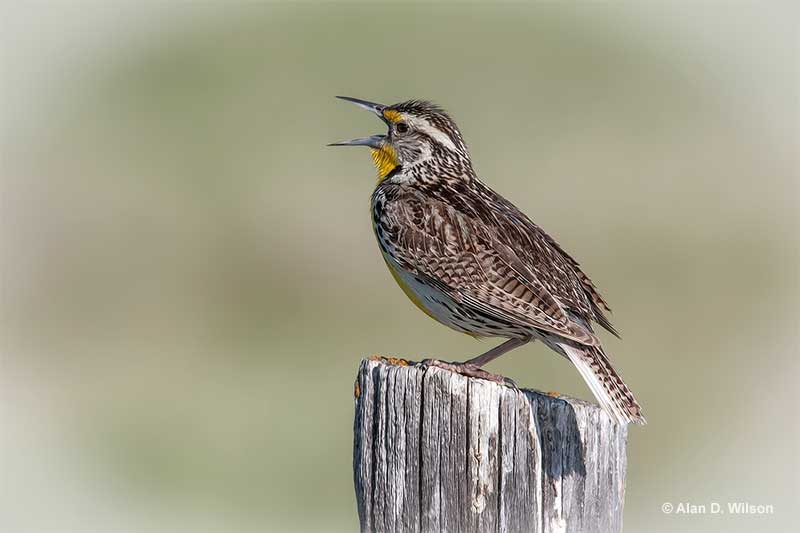
Their efforts encouraged North Dakota and other states to select candidates for their state bird and pass laws to make it official. Sometimes, these organizations would suggest a bird or two, and frequently organized voting campaigns to pick the bird. Most of these “elections” were held in schools throughout a state where children ended up choosing the state bird.
Even so, it was up to state legislatures to make that decision official.
In North Dakota, the choice for state bird was an easy one. In the state’s prairies and wide-open spaces, the Western Meadowlark is one of the more common birds.
With its bright yellow coloration, this pretty blackbird species is also a striking and easy bird to recognize. Even better, it has a pretty, flute-like song that can be heard in every corner of North Dakota.
Fun Facts about Western Meadowlarks
- North Dakota is not the only state that has the honor of calling Western Meadowlark their state bird. Kansas, Montana, Nebraska, Oregon, and Wyoming also use it as their state symbol.
- Western Meadowlarks are not members of the lark family. Although they were named after larks, and live in similar open habitats, meadowlarks are actually in the blackbird family. This is the same family that orioles and grackles belong to.
- At one time, farmers worried that Western Meadowlarks might damage their crops. Thankfully, studies were carried out showing just the opposite. As it turns out, Western Meadowlarks are highly beneficial birds. They act as natural pest control by feasting on grasshoppers and many other agricultural pests.
- This species used to be considered the same as the Eastern Meadowlark. Although they look very similar and can hybridize. They have subtle differences in plumage, song, and habitat. The first modern ornithologist to note this was John James Audubon. He proposed recognizing the Western Meadowlark as a species in 1844!
- Western Meadowlarks have a domed cover over their nest that helps protect and hide it from predators. Their nests can also have entrance tunnels in the grass that measure several feet in length.
- Like other members of the blackbird family, this species sticks its beak into the ground and opens it to loosen dirt and find seeds and insects.
Identification
The Western Meadowlark is a rather chunky bird with longish pale pinks legs, a white tail, and a fairly long and sharp beak. This bird is a little bit larger than a European Starling and is 9.5 inches long, has a wingspan of 14.5 inches, and weighs 3.4 ounces.
This blackbird species has pale brown plumage and yellow breasts with a big black “V” mark on its chest. They have yellow on their throat, in front of their eyes, and on most of their underparts. This species also has a bit of yellow on the lower part of its face, an important field mark to help separate it from the Eastern Meadowlark.
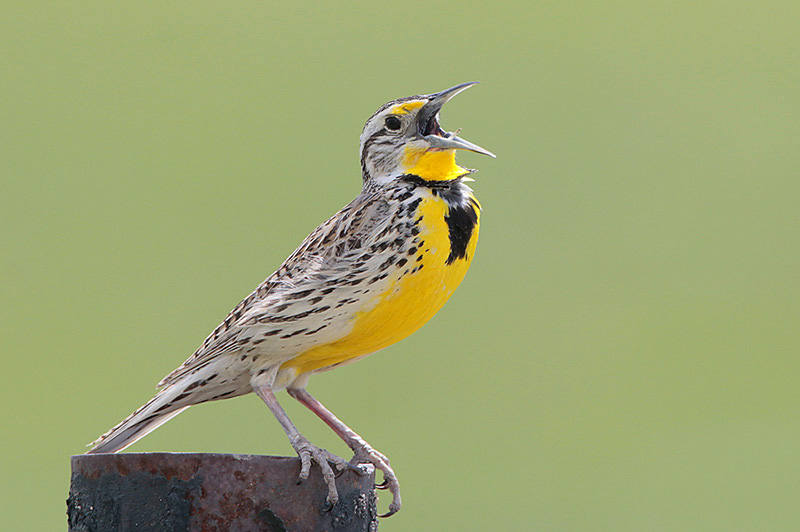
Western Meadowlarks have mottled and streaked, pale brown backs and wings, and white sides with some small black marks. They have a dark crown with fine streaks, a pale face, and a thick black line that goes back from their eyes.
Both sexes of the Western Meadowlark look alike but male birds are just a tiny bit bigger than females. Males also have brighter plumage but both of these differences can be tough to notice. Winter and young birds are a bit paler and their black markings aren’t as bold.
What do Western Meadowlarks eat?
Western Meadowlarks eat a wide variety of insects, other arthropods, and seeds. They feed on grasshoppers, crickets, beetles, ants, and most other invertebrates they catch.
This species forages for bugs and other small creatures by walking in open places with short grass. As it strolls along, it’s always watching for insects in the grass and on the ground. They especially like to forage in open spots with very little vegetation.
When this blackbird species sees an insect, it quickly reaches down to snatch it with its beak. It also pokes its sharp bill into grass stalks and into the ground, and then opens it. This movement can reveal bugs and other food hiding in the soil and in vegetation.
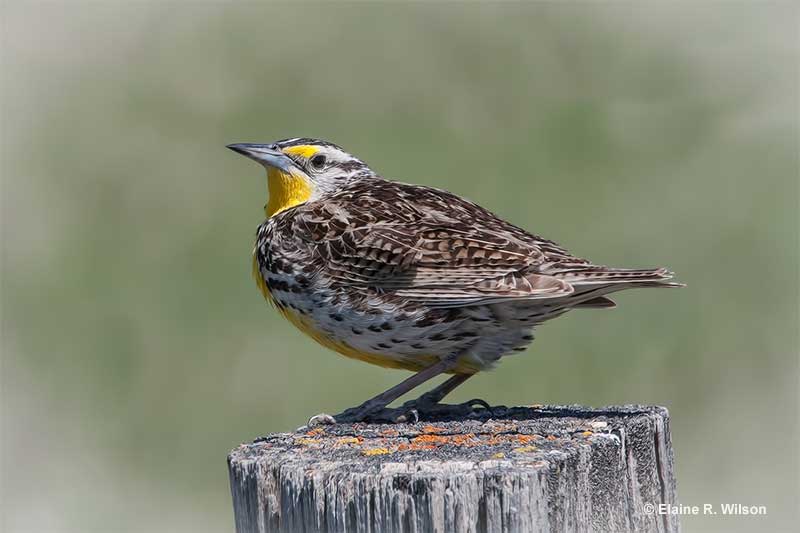
They can also use their beaks to turn over small rocks and bits of dry cow manure.
Western Meadowlarks eat some seeds too, especially during the winter months. They forage for this food by picking them from low plants and from the ground. Once in a while, Western Meadowlarks also eat the eggs and nestlings of other bird species!
They don’t do this all the time but if the parent birds are absent, Western Meadowlarks will occasionally take advantage of such situations.
During the winter months, this species can even feed on carrion!
Call
Western Meadowlarks are very vocal birds. Their beautiful and often heard song is made of short, melodious flute-like whistles, “rip TEE-tur, ripadip”. Males frequently sing any time of the year. However, they are most vocal in spring and summer.
Males will sing while standing on the ground but prefer to sing while perched on a bush, fence posts, or even a pile of rocks.
This meadowlark makes other vocalizations, especially a rattle-like sound. When Western Meadowlarks notice a threat, including people walking too close to their nest, they makes a loud, “chup!” call.
Behavior
We often see Western Meadowlarks as they stand on the ground or a low perches, and as they walk through open habitats with sparse vegetation. They spend most of their time doing these things and can be seen on their own or near their mate.
In the fall and winter months, Western Meadowlarks usually form small flocks. They feed together in the same area but always leave a certain degree of distance between each other.
This species is common in open farm fields, short-grass prairies, pastures, and other open habitats.
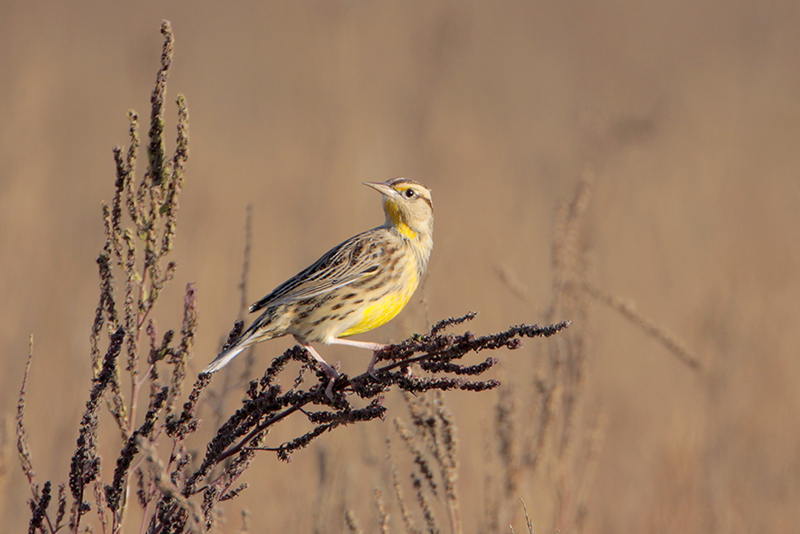
Birders also frequently notice singing male Western Meadowlarks. When singing, these birds love to pick a low perch but can also stand on a rock or even sing while standing on the ground.
In flight, Western Meadowlarks have quick wing beats followed by glides. They can look a lot like a quail with a white tail, and frequently chase each other.
The Western Meadowlark occasionally attacks nests of smaller birds but it doesn’t pose any threat to pets or people. On the contrary, they have to be careful of the cats, foxes, owls, hawks, and other predators that prey on them.
Frequently Asked Questions
What is the state bird of North Dakota?
The state bird of North Dakota is the Western Meadowlark.
Why is the Western Meadowlark the state bird of North Dakota?
The Western Meadowlark is the state bird of North Dakota because this beautiful bird is frequently seen and heard throughout the state.
When did North Dakota choose its state bird?
North Dakota chose its state bird in 1947.
What is North Dakota’s state animal?
North Dakota does not have an official state animal. However, the Nokota Horse is the honorary state equine.
What is the state flower of North Dakota?
The state flower of North Dakota is the Wild Prairie Rose. These state symbols of North Dakota are common and absolutely beautiful.

